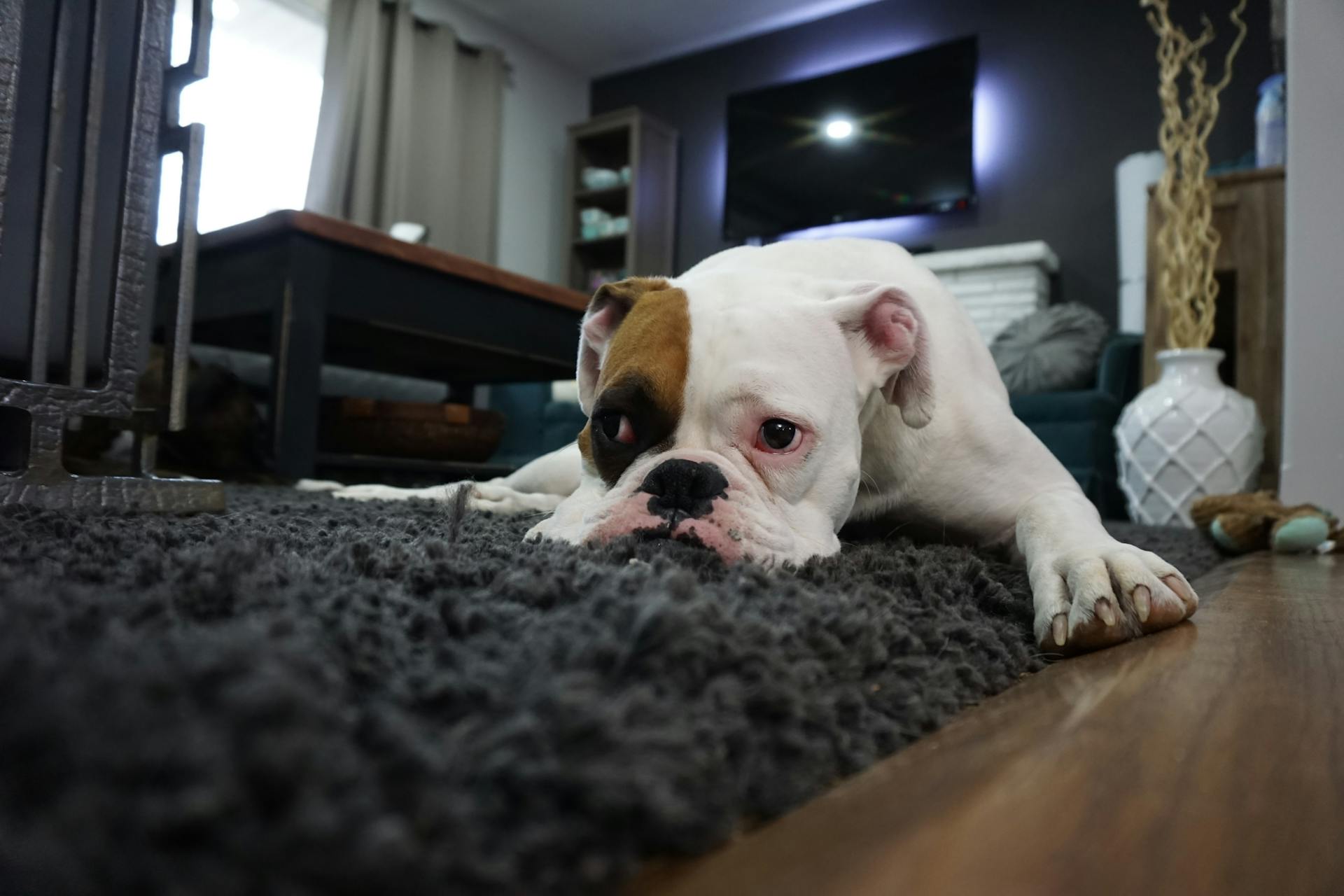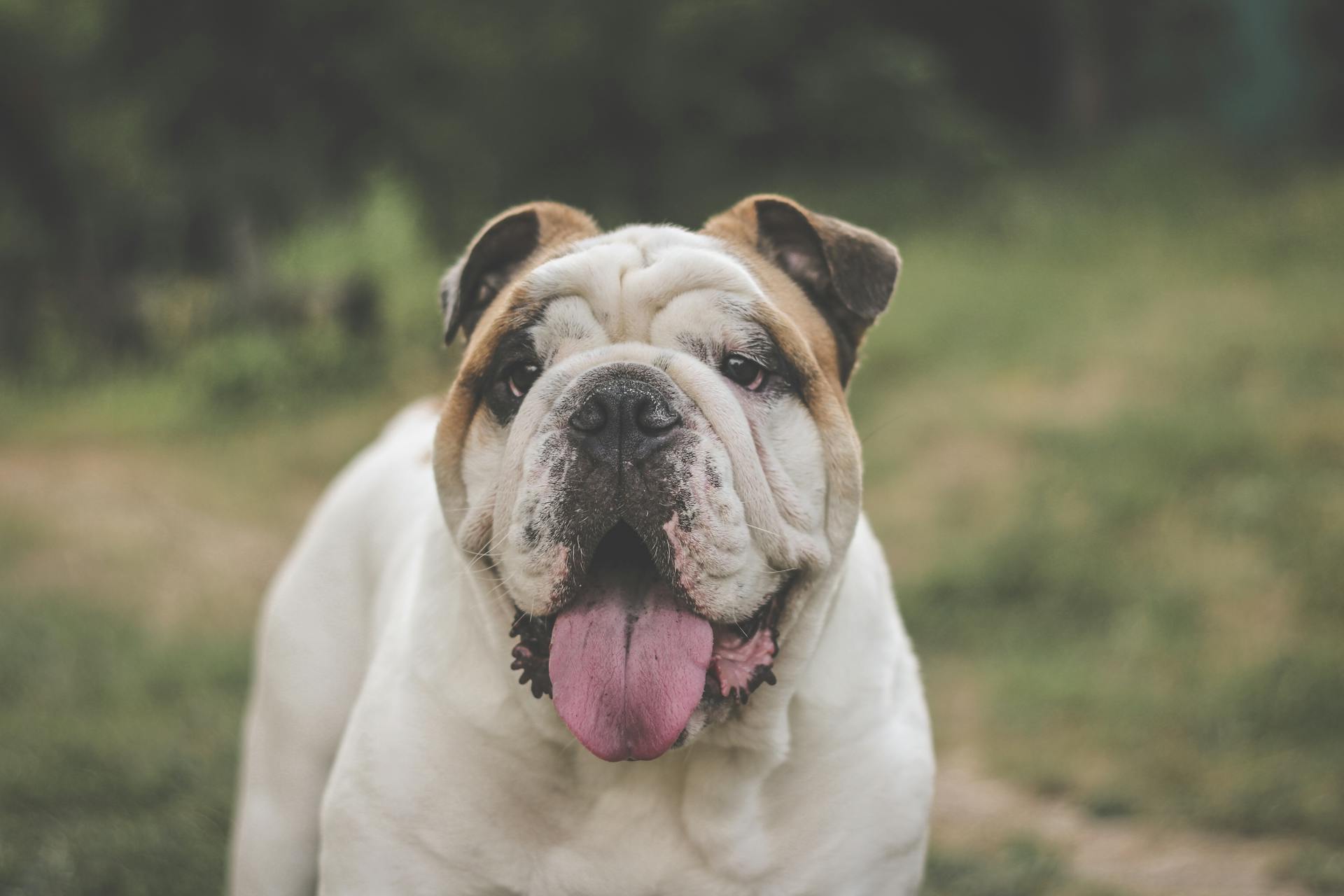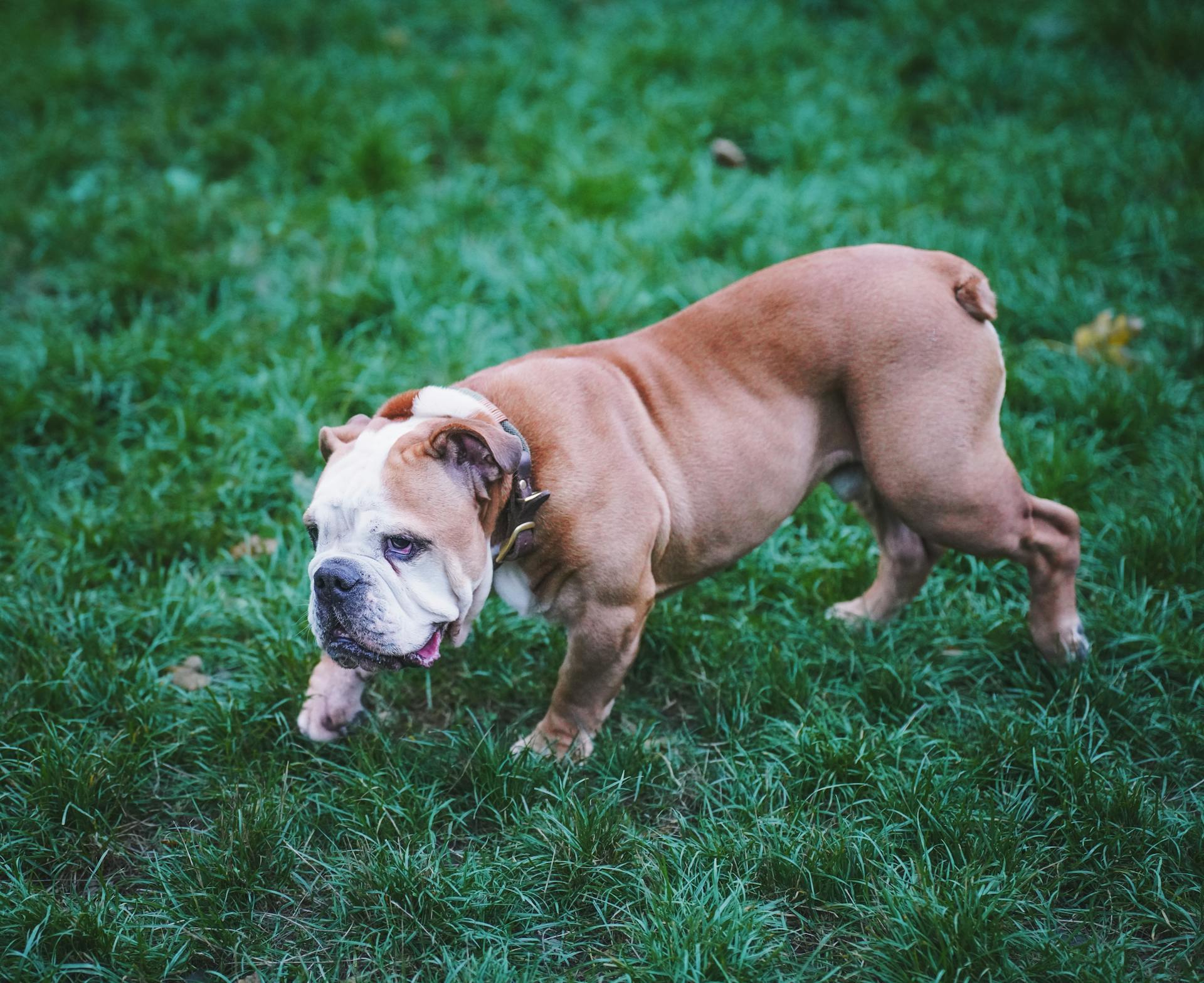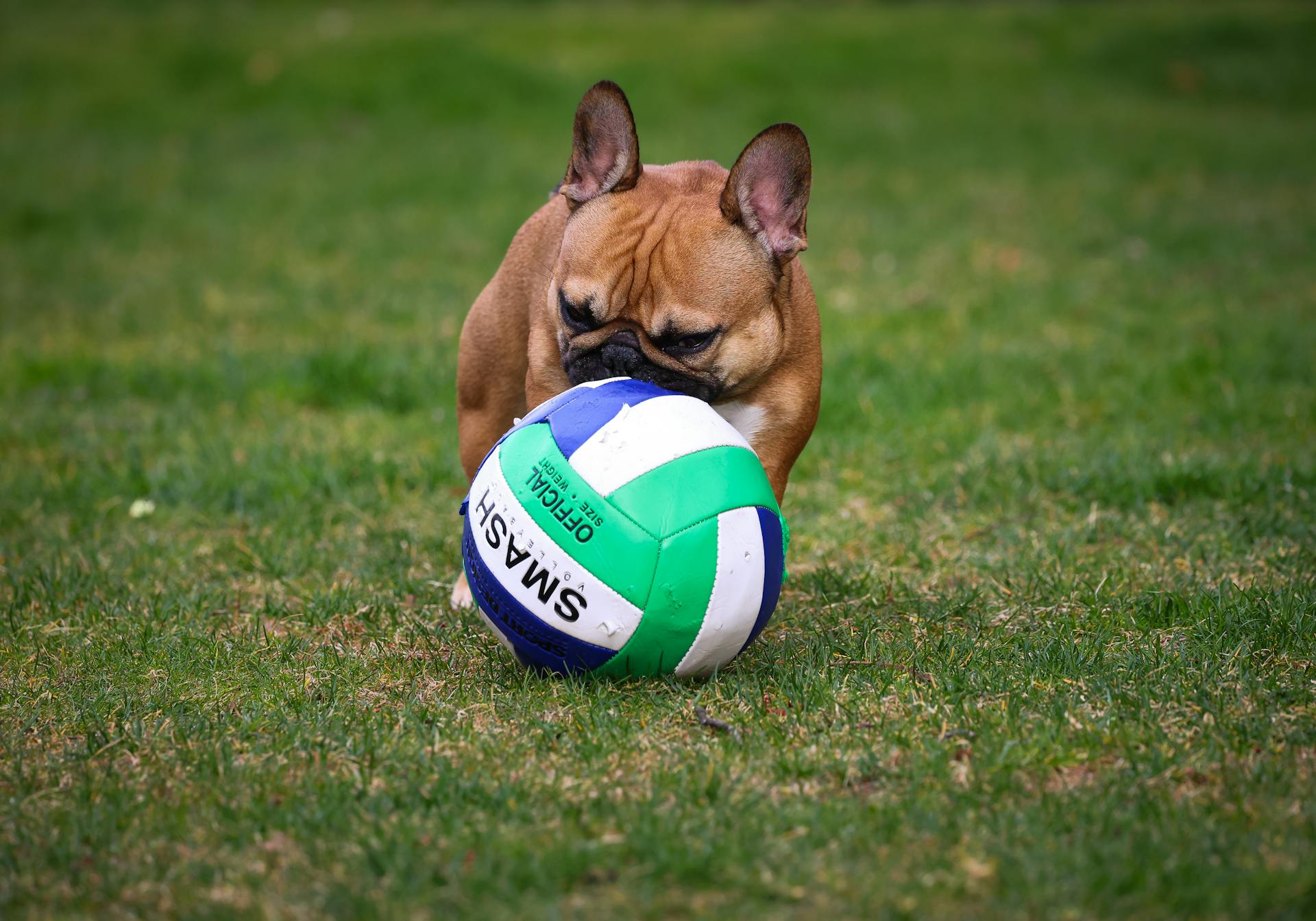
English Bulldogs are prone to skin problems due to their unique facial structure and skin folds.
Their skin folds can trap moisture, dirt, and bacteria, leading to infections and pimples.
Regular cleaning of the skin folds is crucial to prevent the buildup of bacteria and debris.
A gentle cleanser specifically designed for English Bulldogs can help keep their skin clean and healthy.
Daily cleaning of the skin folds can help prevent infections and pimples from forming.
English Bulldogs are also prone to acne due to their skin's oil production and genetic predisposition.
Their skin's oil production can clog pores and lead to acne, making regular cleaning essential.
A well-balanced diet and regular exercise can also help reduce the occurrence of skin problems in English Bulldogs.
Readers also liked: Nasal Surgery for French Bulldogs
Causes and Symptoms
English bulldog pimples can be a real nuisance for both you and your furry friend. One of the main causes of these pimples is bacterial and yeast infections in moist skin folds, which is a common issue in bulldogs due to their wrinkled skin.
English bulldogs are prone to skin conditions that can lead to flaky skin, and a variety of causes can contribute to this, including allergies, parasites, and bacterial or fungal infections.
Severe itching is a common symptom of skin conditions in bulldogs, which can lead to licking, chewing, and rubbing of the entire body, especially around the eyes, muzzle, ears, between the toes, and groin.
Some common signs of skin conditions in bulldogs include severe itching, hair loss, partial or complete, hyperpigmentation, scaling of the skin, skin lesions, superficial pyoderma, secondary infection, and lichenification.
Here are some common causes of skin conditions in bulldogs:
- Bacterial and yeast infections in moist skin folds
- Demodicosis mites (Red Mange Mites)
- Other ectoparasites, such as fleas, ticks, lice or other mites
- Food or environmental allergies
Canine acne is another common skin issue in bulldogs, and it's often caused by a combination of internal and external factors, including genetic predisposition, trauma to the skin, age, and environmental irritants.
In mild cases, canine acne can appear as red bumps or pimples on the skin, similar to human acne, while in severe cases, dogs can present with severe inflammation covering the entire surface of the skin around the muzzle, leading to pain and permanent scarring if not treated.
Here are some common signs of canine acne:
- Small red bumps or pimples around the chin, skin around the mouth, and lower lips of a dog
- Painful or itchy skin
- Generalized swelling of the muzzle area
- Hair loss around the muzzle
If you suspect your pet is suffering from canine acne or any other skin condition, it's essential to contact your vet directly for an assessment and a care plan.
Types of Infections
English bulldog pimples can be caused by a variety of infections, including bacterial, fungal, and parasitic infections. These infections can result in red, itchy bumps on the skin.
Skin fold pyoderma is a bacterial infection that causes lesions such as erythema, alopecia, crusting, and pustules. Other symptoms of localized skin fold pyoderma may include moist skin folds, dried discharge, itchiness, odor, and brown staining of hair.
Pyoderma is a common condition that generates microscopic scales or scabs, often mistaken for hives. It's usually found on a dog's nose, chin, elbows, and hocks, and can be caused by a bacterial infection, allergies, parasites, or in rare cases, cancer.
Here are some of the most common types of infections that can cause skin bumps in English bulldogs:
- Bacterial infections (e.g. skin fold pyoderma)
- Fungal infections
- Parasitic infections
These infections can be uncomfortable and even dangerous for your English bulldog's skin, so it's essential to seek veterinary attention if you notice any unusual bumps or symptoms.
Sebaceous Cyst
Sebaceous cysts are a common issue in English Bulldogs, and they're caused by a blocked sebaceous gland that leads to a buildup of hard, cystic material attached to and under the skin.
Most sebaceous cysts don't cause problems, but they can occasionally burst. A fine needle aspiration is necessary to distinguish them from other masses.
It's always a good idea to have a veterinarian check and identify any changes in your dog's skin, including sebaceous cysts, to determine the underlying cause and decide on a course of therapy if necessary.
English Bulldogs are prone to skin diseases that can result in bumps on their skin fold, including sebaceous cysts, so regular veterinary check-ups are essential.
Areas of Infection
Skin folds are one of the most prevalent places for infections to develop in English bulldogs. Your pet's skin fold is covered with wrinkles and creases, especially around their face, neck, and tail.
These folds can collect moisture, dirt, and debris, fostering the growth of germs and fungus. Regular inspection of skin folds is essential to prevent infections.
Areas prone to skin fold infections include the face, neck, and tail, as well as the armpits and groin areas in some breeds, such as Basset Hounds.
The wrinkles and facial folds in the skin of English Bulldogs can accumulate moisture, debris, and bacteria. Keep these places clean and dry by inspecting them regularly.
Some common areas where infections can form in English Bulldogs include the skin folds, nose, chin, elbows, and hocks. These areas are more prone to bacterial infections, such as pyoderma.
Here are some common areas where skin infections can occur in English Bulldogs:
- Face
- Neck
- Tail
- Armpits (in Basset Hounds)
- Groin area (in Basset Hounds)
- Nose
- Chin
- Elbows
- Hocks
It's essential to keep these areas clean and dry to prevent infections. Regular grooming and inspection can help identify potential issues before they become severe.
Prevention and Treatment
Prevention is key to keeping your English Bulldog's skin healthy and pimple-free. Keeping your dog at a healthy weight can help reduce the prominence of some body folds, but since folds are part of the breed's characteristic makeup, talk to your vet about the areas that may be affected.
Curious to learn more? Check out: Healthy English Bulldog
Regular cleaning of your dog's wrinkles is essential to prevent bacterial overgrowth. Wash those areas with an antimicrobial product that is gentle on the skin and keep moisture to a minimum. This will help prevent localized skin fold dermatitis.
Skin fold dermatitis can be treated with frequent antimicrobial products, but some dogs may be prone to severe infections or recurrence of infection within skin folds. In such cases, surgical treatment to remove deep facial folds may be necessary to prevent inflammation and microbial buildup.
Proper treatment involves addressing the underlying cause of skin lesions. If your dog is licking or scratching in a specific area, you must stop the scratching to break the cycle. Your veterinarian may prescribe topical therapy, medicated washes, or oral antibiotics to treat skin infections.
Regular bathing, using medicated shampoos and conditioners, and thorough rinsing can help eliminate dirt and bacteria that can cause skin allergies. This, combined with regular grooming, can help prevent skin infections.
A fresh viewpoint: English Bulldog Hip Dysplasia Treatment
Diagnosis and Recovery
Your veterinarian will need to rule out other possible causes that may be causing your English bulldog's skin issue, so be prepared to share any new foods, changes in routine, or stressors that may be contributing to the problem.
A full physical exam will be performed on your dog to check for other areas of sensitivity that have not yet developed into a skin infection but are susceptible to it.
Your veterinarian may want to clean the affected area of skin to allow them a better look at the lesion, and clipping the area will remove excess fur from the region which will improve ventilation and allow for easier cleaning.
Preventing skin conditions in English bulldogs is key, and a good, balanced diet along with skin supplements like fish oil can help keep their skin healthy.
Keeping your dog's skin as healthy as possible can reduce the risk of infection, and avoiding any identified allergens is crucial to preventing skin problems.
Diagnosis

Your veterinarian will need to rule out other possible causes that may be causing the skin issue, even if the location of the skin issue gives them information about your dog's condition.
They'll perform a full physical exam on your dog to check for other areas of sensitivity that have not yet developed into a skin infection but are susceptible to it.
Your veterinarian may want to clean the affected area of skin to allow them a better look at the lesion by clipping the area to remove excess fur from the region.
They'll check for evidence of parasites during the exam to see if they are a contributing factor to the skin issue.
Your veterinarian will also assess for underlying health issues, such as endocrine disorders, which make infections more likely.
If they find evidence of fleas or other ectoparasites, they'll treat them as part of the diagnostic process.
A skin swab sample may be taken to verify what type of bacteria or yeast is colonizing in the area, especially if it's in a location with a skin fold.
Further diagnostics may be recommended depending on the suspected cause of your dog's condition.
Recovery

Recovery from skin conditions in Bulldogs requires a multi-faceted approach.
Preventing skin conditions is your best treatment option, but even with thorough cleaning, some dogs are still prone to infection.
Keeping your Bulldog's skin healthy can be helped by offering a good, balanced diet as well as skin supplements like fish oil.
Your veterinarian may recommend specific wipes for areas of excessive moisture or a medicated shampoo to prevent bacteria and yeast growth.
If you take care of your dog's skin properly, they should have fewer issues than others of their breed.
Any identified allergens in the diet or environment need to be avoided where possible.
A fresh viewpoint: Staph Infection English Bulldog Skin Conditions Pictures
Home Care and Neglect
Home care for English bulldog pimples can be a challenge, but it's not impossible. The good news is that most cases of canine acne can be managed with proper treatment.
If you don't take action, mild cases of dog acne may resolve on their own, but most cases require some form of treatment. In severe cases with deep skin infections, a course of oral antibiotics is often required.
Here are some common mistakes to avoid when it comes to home care: Not following a veterinarian's treatment planStopping treatment early, which can lead to recurrence, drug resistance, and other issues
Readers also liked: English Bulldog Care
Check for Folds

As you care for your English bulldog, it's essential to check for skin folds regularly. These folds can collect moisture, dirt, and debris, fostering the growth of germs and fungus.
English and French bulldog pups can suffer from abnormal tail bone growth that will twist the skin around and under the sacral vertebrae creating a deep pocket of skin folds. This condition is sometimes called the corkscrew tail. Management of tail folds can be more hands-on.
Bassett hounds may be prone to armpit and groin fold dermatitis. Regularly inspect these areas to catch any potential infections early. Keep in mind that some pets can be quite sensitive in these areas if an infection is present.
Lip fold dermatitis may occur in some dogs with a pronounced lip fold on the lower lip. It's crucial to keep these areas clean and dry to prevent infections. You can use a medicated wipe to gently wipe the deep fold.
Skin folds are one of the most prevalent places for infections to develop in English bulldogs. Regularly inspect your pet's skin folds, especially around their face, neck, and tail, to catch any potential issues.
You might enjoy: English Bulldog Growth Pictures
Home Remedies for Dog Care
Keeping your dog's skin clean and dry, especially around the muzzle, can help prevent canine acne from occurring or recurring. Gently wash your dog's face with a mild canine-specific shampoo and pat the area with a clean towel after bathing.
Avoid using plastic bowls, as they can cause irritation to the skin. Instead, use food and water bowls made out of stainless steel or ceramic.
Poor nutrition can contribute to skin and hair coat problems in dogs, so it's essential to monitor your dog's diet. Follow your veterinarian's dietary recommendations, especially if they recommend hypoallergenic food for your dog.
If you notice any unusual lesions on your dog's skin, consult your veterinarian for advice. Squeezing pimples or red bumps can lead to more inflammation or a secondary bacterial infection.
To keep your dog's skin healthy, consider the following tips:
- Keep your dog's skin clean and dry
- Avoid using plastic bowls
- Monitor your dog's diet
- Consult your veterinarian if you notice unusual lesions
What If I Neglect My Dog?
If you neglect your dog's acne, it's likely to get worse over time. Most cases of dog acne require some form of treatment, even if it's just a mild one.
Neglecting your dog's acne can lead to more severe cases of deep skin infections, like pyoderma, which may require a course of oral antibiotics.
You may wonder if minor cases of dog acne will resolve on their own, but the truth is that most cases need some kind of treatment.
Hot Spots
Hot spots are a common issue in English bulldogs, and they can be excruciatingly painful. Bulldogs are particularly prone to hot spots, also known as "bulldog hot", which can inflict agony when scratched or handled.
English bulldogs are a difficult breed to diagnose with hot spots because they're often painless and prurient, making it harder for your veterinarian to fully examine the problem. Hot spots are frequently caused by environmental stimuli that can create tumors, such as chemicals, viruses, and solar radiation.
During the summer months, hot spots can emerge out of nowhere and spread quickly, making it essential to keep an eye out for signs of hot spots. Insect bites can also trigger hot spots, so it's crucial to keep your dog's skin clean and free from irritants.
For another approach, see: English Bulldog Hot Spots
Some common causes of the itching/scratching cycle in dogs include ear or skin infections, parasites, food allergy dermatitis, food allergies, moisture trapped in the coat, anal sac disease, contact irritants, and a dirty or matted coat.
Here are some common causes of hot spots in English bulldogs:
- Ear or skin infections
- Parasites
- Food allergy dermatitis
- Food allergies
- Moisture trapped in the coat
- Anal sac disease
- Contact irritants
- The coat that is dirty or matted
If you suspect your English bulldog has a hot spot, it's essential to seek veterinary attention as soon as possible to prevent the infection from spreading and to get your pet feeling better as soon as possible.
Frequently Asked Questions
What is the bump on my bulldog's chin?
A bump on your bulldog's chin could be a sign of dog acne, characterized by red bumps, hairless areas, and swelling. Learn more about the symptoms, causes, and treatment options for dog acne to determine the best course of action for your pet.
Sources
- https://www.walkervillevet.com.au/blog/help-dog-lump/
- https://www.vetdermclinic.com/bulldog-problems-know-skin-folds-avoid-infections/
- https://wagwalking.com/condition/skin-conditions-bulldogs
- https://www.dogster.com/ask-the-vet/canine-acne-vet-answer
- https://www.bulldogology.net/english-bulldog-skin-bumps/
Featured Images: pexels.com


